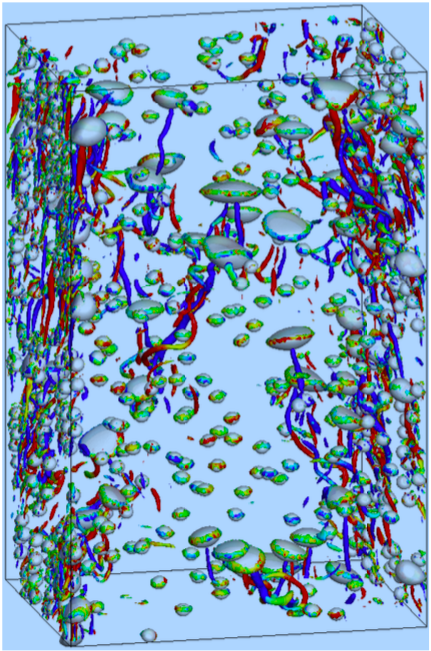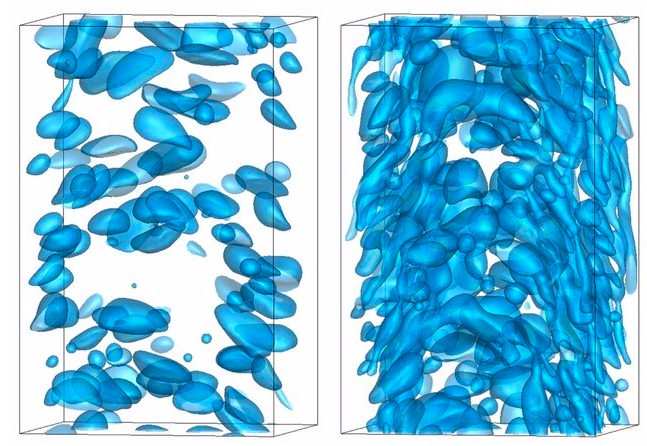Bubbly multiphase flows play a critical role in many industrial processes, including the production of synthetic fuel, as well as in determining the transfer of gases between the atmosphere and the oceans. We have done a large number of studies of bubbly flows. Our initial studies of the unsteady motion of several bubbles at finite Reynolds numbers included only “pseudo turbulence” generated by the bubbles. In addition, our first papers focused mostly, but not exclusively, on 2D fully periodic flows. The interactions of several bubbles and, in particular, how averaged quantities converged as the size of the system increased, was examined in [7, 8]. Although 2D flows show many of the same processes found in fully 3D flows, some aspects are fundamentally different and in some cases an inverse energy cascade, somewhat similar to forced 2D single phase flows emerges [6]. More complete results for 3D flows in periodic domains [1–3] showed that nearly spherical bubbles and more deformed ones interact very differently. In particular, while nearly spherical bubbles have a tendency to line up side by side, deformed bubbles can undergo a “streaming” instability where the bubbles rise in concentrated columns. Our first study of bubbles in fully turbulent flows focused on drag reduction where it was shown that deformed bubbles sliding along the wall reduce streamwise vorticity, causing drag reduction [11]. Flows in vertical channels, where buoyancy drives the bubble motion upward, have been examined in a several papers. In [10] we examined the void fraction distribution in upflow for nearly spherical bubbles in laminar upflow and showed that it and the average velocity profiles can be explained based on the sign of the lift force on the bubble and that at steady state the void fraction is easily predicted by a simple analytical expression. The effect of bubble deformability for turbulent upflow was studied in [13] where it was confirmed that the void fraction distribution is peaked near the walls for nearly spherical bubbles, but deformable bubbles result in core peaked distribution. The void fraction distribution at stationary state for a large number of nearly spherical bubbles in turbulent channel flows was examined in [15] where it was shown that the void fraction distribution does not depend on the system size and that the addition of one large bubble had minor effects. For downflow we have examined the effect of void fraction [13] and bubble size [14]. The transition between wall peak and core peak in upflow was studied further in [4] who found a very sharp transition between those states as the Eo ̈tvo ̈s number changed. Most recently we have been examining flows where the bubbles coalesce and break apart again repeatedly [16, 17]. The effect of bubbles on the heat transfer in turbulent flows in vertical and sloping channels was examined by [5, 18], and [12] showed that insoluble surfactant can change completely the void fraction distribution for nearly spherical bubbles in vertical channels. The figures show a few of examples from simulations of turbulent bubbly flows. In the first movie several deformable bubbles are rising in turbulent flow in a relatively short vertical channel. The second movie shows bubbles in a longer channel, where heat transfer in included [5]. In the third figure we study the effect of polydispersity [19], and visualize the vorticity by plotting isosurfaces of λ2 [9]. In the two frames in the last figure the bubbles are allowed to coalesce and while the modest void fraction case (left frame) results in bubbly flows, at higher void fractions the topology of the interface is more complex [16]. More details about the specific flow conditions and various statistical quantities can be found in the cited papers.


References
[1] B. Bunner and G. Tryggvason. Dynamics of homogeneous bubbly flows: Part 1. rise velocity and microstructure of the bubbles. Journal of Fluid Mechanics, 466:17–52, 2002.
[2] B. Bunner and G. Tryggvason. Dynamics of homogeneous bubbly flows. part 2, fluctuations of the bubbles and the liquid. Journal of Fluid Mechanics, 466:53–84, 2002.
[3] B. Bunner and G. Tryggvason. Effect of bubble deformation on the stability and properties of bubbly flows. Journal of Fluid Mechanics, 495:77–118, 2003.
[4] S. Dabiri, J. Lu, and G. Tryggvason. Transition between regimes of a vertical channel bubbly upflow due to bubble deformability. Physics of Fluids, 25:102110 (12 pages), 2013.
[5] S. Dabiri and G. Tryggvason. Heat transfer in turbulent bubbly flow in vertical channels. Chemical Engineering Science, 122:106–113, 2015.
[6] A.EsmaeeliandG.Tryggvason.Aninverseenergycascadeintwo-dimensional,lowReynoldsnumber bubbly flows. Journal of Fluid Mechanics, 314:315–330, 1996.
[7] A. Esmaeeli and G. Tryggvason. Direct numerical simulations of bubbly flows. Part I—low Reynolds number arrays. Journal of Fluid Mechanics, 377:313–345, 1998.
[8] A. Esmaeeli and G. Tryggvason. Direct numerical simulations of bubbly flows. Part II—moderate Reynolds number arrays. Journal of Fluid Mechanics, 385:325–358, 1999.
[9] J. Jeong and F. Hussain. On the identification of a vortex. Journal of Fluid Mechanics, 285:69–94, 1995.
[10] J. Lu, S. Biswas, and G. Tryggvason. A DNS study of laminar bubbly flows in a vertical channel. International Journal of Multiphase Flow, 32:643–660, 2006.
[11] J. Lu, A. Fernandez, and G. Tryggvason. The effect of bubbles on the wall shear in a turbulent channel flow. Physics of Fluids, 17:095102, 2005.
[12] J. Lu, M. Muradoglu, and G. Tryggvason. Effect of insoluble surfactant on turbulent bubbly flows in vertical channels. International Journal of Multiphase Flow, 95:135–143, 2017.
[13] J. Lu and G. Tryggvason. Numerical study of turbulent bubbly down flows in a vertical channel. Physics of Fluids, 18:103302 (10 pages), 2006.
[14] J. Lu and G. Tryggvason. Effect of bubble size in turbulent bubbly downflow in a vertical channel. Chemical Engineering Science, 62:3008–3018, 2007.
[15] J. Lu and G. Tryggvason. Dynamics of nearly spherical bubbles in a turbulent channel upflow. Journal of Fluid Mechanics, 732:166–189, 2013.
[16] J. Lu and G. Tryggvason. Direct numerical simulations of multifluid flows in a vertical channel undergoing topology changes. Physical Review Fluids, 3:084401 (20 pages), 2018.
[17] J. Lu and G. Tryggvason. Multifluid flows in a vertical channel undergoing topology changes–effect of void fraction. Physical Review Fluids, page Accepted, 2019.
[18] S.Piedra, J. Lu, E.Ramos, and G. Tryggvason. Numerical study of the flow and heat transfer of bubbly flows in inclined channels. International Journal of Heat and Fluid Flow, 56:43–50, 2015.
[19] G.Tryggvason, M. Ma, and J. Lu. DNS assisted modeling of bubbly flows in vertical channels. Nuclear Science and Engineering, 184:312–320, 2016.